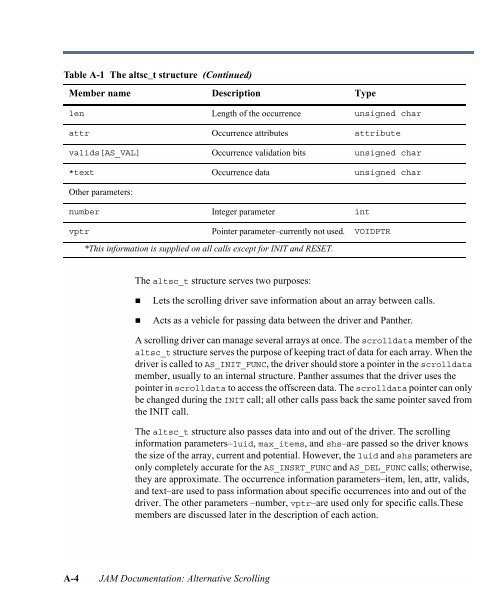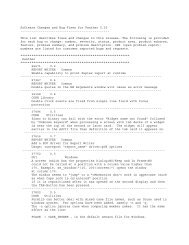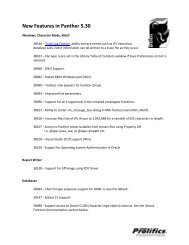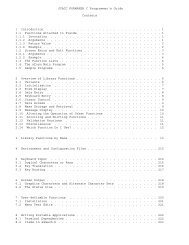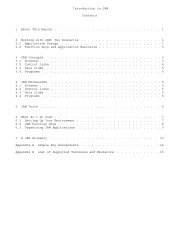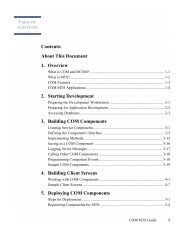- Page 1 and 2:
TABLE OFCONTENTSContents:About This
- Page 3 and 4:
PantherUpgrade GuideRelease 5.4Docu
- Page 5 and 6:
TABLE OFCONTENTSContents:About This
- Page 8 and 9:
Dockable Toolbars..................
- Page 10 and 11:
Utilities..........................
- Page 14 and 15:
How to Print the DocumentHow to Pri
- Page 17 and 18:
CHAPTER1 Upgrading toPanther from J
- Page 19 and 20:
EditorEditorMenu ChangesFile MenuEd
- Page 21 and 22:
EditorOptions Menufiles to, and ext
- Page 23 and 24:
EditorLibrary Member AccessJPL Modu
- Page 25 and 26:
EditorDocking ToolbarsFor Windows a
- Page 27 and 28:
Development and DeploymentLibrary L
- Page 29 and 30:
Development and DeploymentJPL Progr
- Page 31 and 32:
UtilitiesMSVC Project FilesMSVC pro
- Page 33 and 34:
Utilitiesr2ascThe r2asc utility has
- Page 35:
ConfigurationSMJAVALIBRARY specifie
- Page 38 and 39:
API Changessm_obj_get_propertyGet t
- Page 40 and 41:
API ChangesActiveX ControlsFor Acti
- Page 42 and 43:
API ChangesCard Expose Function (ex
- Page 44 and 45:
API ChangesConnection Pooling (conn
- Page 46 and 47:
API ChangesCount Result (count_resu
- Page 48 and 49:
API ChangesSelect Function Name (se
- Page 50 and 51:
API ChangesRELEASEThe transaction m
- Page 52 and 53:
API ChangesHTML Name (html_name)Rea
- Page 54 and 55:
API ChangesToolbar Coordinates (too
- Page 56 and 57:
API ChangesEXTLEEXTPDEXTPUEXTREXTWL
- Page 58 and 59:
Database Interface" sm_d_msg_read
- Page 60 and 61:
Transaction ManagerTransaction Mana
- Page 62 and 63:
Web Application DevelopmentOne Init
- Page 64 and 65:
Web Application DevelopmentNew Synt
- Page 66 and 67:
Web Application DevelopmentDetermin
- Page 68 and 69:
ReportsReportsConverting ReportWrit
- Page 70 and 71:
Upgrading to JetNetEditor! On the F
- Page 72 and 73:
Upgrading to JetNetservers when the
- Page 74 and 75:
Upgrading to JetNetEnvironment Vari
- Page 76 and 77:
Upgrading to JetNetadvertise notify
- Page 78 and 79:
Upgrading to JetNettp_mon_exc_msgtp
- Page 80 and 81:
Upgrading to Panther for IBM WebSph
- Page 82 and 83:
DocumentationCGI variablesIn Web ap
- Page 84 and 85:
DocumentationPropertiesColumn Click
- Page 86 and 87:
Documentation1-70 Upgrading to Pant
- Page 88 and 89: Running JAM to Panther! Choose Next
- Page 90 and 91: Running JAM to Panther! Enter the p
- Page 92 and 93: Running JAM to Panther2-6 Using the
- Page 94 and 95: 3-2 Upgrading to Oracle Tuxedo from
- Page 96 and 97: Upgrade PathsUpgrade PathsThere are
- Page 98 and 99: Upgrading the Operating Environment
- Page 100 and 101: Upgrading the Operating Environment
- Page 102 and 103: Converting an ApplicationConverting
- Page 104 and 105: Converting an Applicationexpect the
- Page 106 and 107: The f5upg UtilityThe Bottom LinePla
- Page 108 and 109: The f5upg UtilityJAM7_screenThe nam
- Page 110 and 111: The f5upg UtilityVerbosity LevelThe
- Page 112 and 113: The f5upg UtilityConversion of Menu
- Page 114 and 115: The f5upg Utility" The screen you a
- Page 116 and 117: The dd5upg Utility-vPrints the name
- Page 118 and 119: The dd2rec UtilityThe dd2rec Utilit
- Page 120 and 121: The dd2rec Utility4-26 Upgrading to
- Page 122 and 123: All ApplicationsAll ApplicationsTab
- Page 124 and 125: All ApplicationsTable 5-3 Library F
- Page 126 and 127: All ApplicationsTable 5-3 Library F
- Page 128 and 129: All ApplicationsTable 5-5 Screens (
- Page 130 and 131: GUI ApplicationsTable 5-8 Utilities
- Page 132 and 133: GUI ApplicationsTable 5-11 Screen,
- Page 134 and 135: Character ApplicationsTable 5-14 Sc
- Page 136 and 137: Normally, a non-scrolling widget ca
- Page 140 and 141: attrvalidstextDisplay attribute to
- Page 142 and 143: function is called repeatedly. No b
- Page 144 and 145: typedefstruct sc_buf_s{struct sc_bu
- Page 146 and 147: }(unsigned)(SC_BUF_SIZE - SC_OVERHE
- Page 148 and 149: ptr = 0;}as_ptr->item = item_to;if
- Page 150 and 151: }if (!new_luid){mb_free_sc_bufs(scr
- Page 152 and 153: */static sc_buf_t * SMLOCALmb_addsc
- Page 154 and 155: *}sc_buf = f_buf;}while ((ret_buf =
- Page 156 and 157: A-22 JAM Documentation: Alternative
- Page 158 and 159: Processing Keyboard InputProcessing
- Page 160 and 161: Processing Keyboard InputWith Timin
- Page 162 and 163: Processing Terminal OutputHow Panth
- Page 164 and 165: Function Name Made Obsolete In Desc
- Page 166 and 167: sm_com_call_methodCalls a method of
- Page 168 and 169: proc entryid = sm_com_obj_create("c
- Page 170 and 171: sm_com_logWrites a message to an er
- Page 172 and 173: sm_com_obj_destroyRemoves a COM com
- Page 174 and 175: sm_com_onerrorInstalls an error han
- Page 176 and 177: sm_com_raise_exceptionSends an erro
- Page 178 and 179: sm_com_return_argsReturns a method'
- Page 180 and 181: When setting properties for ActiveX
- Page 182: Indexget data A-6initialize A-7inse


